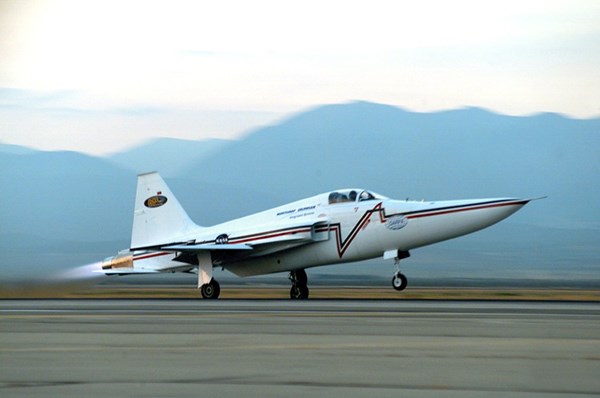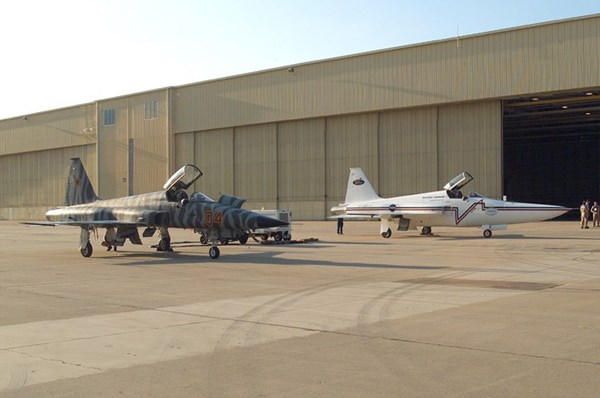EL SEGUNDO, Calif., Aug. 28, 2003 (PRIMEZONE) --
NOTE FOR EDITORS:
Officials from DARPA, Northrop Grumman and NASA will discuss the results of the sonic boom demonstration at a media briefing scheduled for 9 a.m. EDT Wednesday, Sept. 3, in the First Amendment Lounge at the National Press Club, 529 14th Street NW. Media interested in attending should contact Gus Gulmert in Northrop Grumman's Washington, D.C., office at 703-875-8450 or via e-mail at gus.gulmert@ngc.com.
Northrop Grumman Corporation's (NYSE:NOC) Integrated Systems sector, in cooperation with the Defense Advanced Research Projects Agency (DARPA) and NASA, has made aviation history by demonstrating a method to reduce the bone-jarring impact of sonic booms, a technology that could usher in a new era of supersonic flight.
Photos accompanying this release are available at: http://media.primezone.com/noc/
In flights conducted Aug. 27 on the same supersonic test range where Chuck Yeager first broke the sound barrier nearly 56 years ago, the government/industry team showed that modifying an aircraft's shape can reduce the intensity of its sonic boom. This theory had never been demonstrated in actual flight.
The technology, being developed as part of DARPA's Quiet Supersonic Platform (QSP) program, could eventually lead to unrestricted supersonic flight over land.
"During this centennial year of manned flight, Northrop Grumman has demonstrated once again that it remains on the cutting edge of technical innovation," said Charles Boccadoro, Northrop Grumman's QSP program manager. "This theory had been demonstrated only in laboratories and wind tunnels. It took a cooperative effort of government and industry to achieve this breakthrough."
An aircraft traveling through the atmosphere continuously produces air-pressure waves similar to waves created by the bow of a ship. When the aircraft exceeds the speed of sound (approximately 750 mph at sea level), the pressure waves combine to form shock waves, which are heard as a sonic boom when they reach the ground.
The flights were conducted at the NASA Dryden Flight Research Center at Edwards Air Force Base, Calif. An F-5E aircraft with a specially modified nose section flew supersonically through the test range, and sensors on the ground and in other aircraft measured the sonic boom overpressure. Shortly thereafter, an unmodified F-5E flew supersonically through the same airspace. The data comparison of the two aircraft signatures clearly showed a reduction in intensity of the sonic boom produced by the F-5E with a modified fuselage. An identical test later in the day confirmed these results.
"The demonstration has proven the theory that you can reduce sonic boom intensity by changing aircraft shape, and engineers will be able to study the data to learn more about the effects of aircraft shaping on sonic overpressure," said Boccadoro. "Based on those studies, an experimental aircraft could eventually be built that will produce a noticeably quieter sonic boom."
The Shaped Sonic Boom Demonstration (SSBD) program is a $7 million cooperative agreement with Northrop Grumman, DARPA and NASA's Langley Research Center and Dryden Flight Research Center. Other government and industry entities are participating in the program.
The F-5E's modifications, which were designed and installed by Northrop Grumman, include a specially shaped "nose glove" and the addition of aluminum substructure and a composite skin to the underside of the fuselage. The U.S. Navy's Naval Air Systems Command provided the F-5E aircraft.
Northrop Grumman's SSBD team includes Wyle Laboratories, El Segundo, and Eagle Aeronautics, Hampton, Va. Also participating in the SSBD program are General Electric Co., Lockheed Martin Corp. and The Boeing Co. General Electric provided technical assistance with the aircraft engines, Lockheed Martin supplied ground-based sensors and Boeing provided a T-38 chase aircraft for the initial F-5E envelope expansion flights.
DARPA's QSP program is an effort to identify and mature technologies that could allow military and business aircraft to operate with reduced sonic boom. Northrop Grumman Integrated Systems has been working under contract with the QSP program since 2000 at its Advanced Systems Development Center in El Segundo. As part of that work, the company has designed a long-range supersonic military aircraft and validated key integration technologies associated with that design.
Northrop Grumman Integrated Systems, based in El Segundo, is a premier aerospace and defense systems integration enterprise. As one of Northrop Grumman Corporation's seven sectors, it designs, develops, produces and supports network-enabled integrated systems and subsystems for U.S. government, civil and international customers. Integrated Systems delivers best-value solutions, products and services that support military missions in the areas of intelligence, surveillance and reconnaissance; battle management command and control; and integrated strike warfare.
Members of the news media may receive our releases via e-mail by registering at: http://www.northropgrumman.com/cgi-bin/regist_form.cgi
LEARN MORE ABOUT US: Northrop Grumman news releases, product information, photos and video clips are available on the Internet at: http://www.northropgrumman.com. Information specific to the Integrated Systems sector is available at: www.is.northropgrumman.com/index.html

